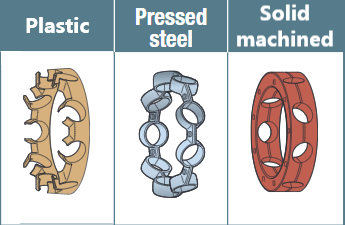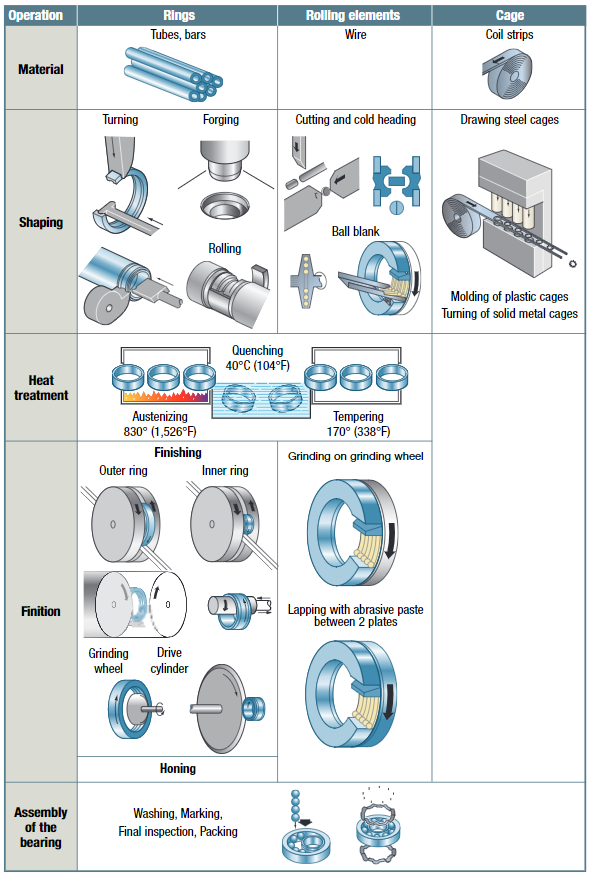Materials and manufacturing
Have you already had a look at our chapter on structure and function? Maybe you asked yourself what rolling bearings are actually made of. You can find some answers to these questions and further background information on rolling bearing production here.
Materials: Rolling elements and bearing rings
In most cases, both the rolling elements and the bearing rings are made of rolling bearing steel, which is standardised according to designation 100Cr6. The steel used must be of high purity and should contain only the smallest metallic inclusions. Another important requirement is that the material must be able to withstand high loads. This is the only way to guarantee that the rolling bearings will maintain high precision and rotational accuracy. The materials from which the rings and rolling elements are made should also have a high hardness after machining. They must alsohave good resistance to rolling fatigue and wear, and have sufficient dimensional accuracy. At NTN, the Japanese rolling bearing steel designated “SUJ2“, (equivalent to 100Cr6), is used.
Nowadays, rolling elements can also be made of ceramic. This offers various advantages. For example, ceramic rolling elements are lighter than steel rolling elements, which leads to lower centrifugal forces and thus better energy efficiency. Ceramic rolling elements are therefore used at very high speeds and are also suitable for cold and extremely high operating temperatures. Another advantage of ceramic rolling elements is that they prevent the passage of current through the bearing, as they are not electrically conductive. The bearing rings can also be made of ceramic, but this is very rare and only necessary for special applications with extreme temperatures.
Materials: Cage
With regard to the cages, it should be noted that they must have sufficient strength in order to be able to absorb vibration and impact loads. In addition, the cage materials should have a low coefficient of friction, low weight and be able to withstand the temperatures generated by the bearing. Small and medium-sized rolling bearings are generally fitted with sheet steel cages, while large bearings tend to be fitted with solid cages, which are mostly made of brass. Brass cages are suitable for strong vibrations and can withstand greater loads during acceleration and deceleration of the rolling elements compared to sheet steel cages. Additionally, cages made of plastic are also used. These cages are well suited to strong vibrations and are characterised by the fact that their friction, temperature and noise generation are low overall.
| Cage material | Advantages and disadvantages |
| Sheet steel | Advantages: Does not restrict the operating temperature of the bearing, cost-effective Disadvantages: Only limited suitability for vibratory applications |
| Brass | Advantages: No temperature restriction, suitable for vibratory applications, good resistance to extreme accelerations Disadvantages: Expensive |
| Plastic | Advantages: Elastic and suitable for strong vibrations, low temperature and noise generation, low friction Disadvantages: Limited operating temperature |
Here you will find an overview of the advantages and disadvantages of the three cage materials
Manufacturing of bearing rings
It isn’t just the materials used in the production of rolling bearings, but also how they are manufactured which is interesting. Raw material in the form of tubes or rods are used for bearing rings. These are initially either machined or formed. In machining, the rings, which are in a cold state, are coarsely and finely turned with a cutting tool. Forming is divided into forging and rolling. In forging, a previously heated blank is re-shaped. The material, which remains warm, is then further shaped in the process of rolling by turning it with the help of a shaping tool. After the steel has been processed into a ring shape using one of the two methods, the rings are first heated to their phase transformation temperature in the process of austenitisation. Then, the bearing rings are quenched. The aim here is for the rings to achieve the desired hardness. In the third step, during tempering, the steel is heated again to reduce the residual stresses that have developed in the material. To produce the final shape, the bearing rings are now ground further so that the diameters of the rings are brought to the desired size and the bearing raceways are completely machined.
Manufacturing of rolling elements
Steel in the form of round bars is used as the raw material for the rolling elements. The blank, as it is known, is cut to length, pressed, punched and deep-drawn before being shaped into a round form with the help of a ball mill. Rolling elements are also subjected to the same heat treatment as the inner ring and outer ring. The geometry of the balls is then improved by grinding them in several machining stages. In the final machining stage, the rolling elements are inspected, sorted and preserved.
Manufacturing of cages
The process of cage production using a sheet steel cage as an example, can be described as follows: First, a sheet steel strip is punched out and shaped so that that pockets are created for the rolling elements. The cage consists of two halves, which are later joined either by spot welding or riveting. After the balls have been inserted and positioned between the bearing rings, the cage can be inserted and both halves joined.
| Material | Components | Advantages and disadvantages |
| Steel | Bearing rings, rolling elements | Advantages: Withstands high loads and impact forces, not susceptible to breakage, quieter than ceramics Disadvantages: High weight and quite low limiting speeds, not suitable for temperatures above 120°C as standard without special heat treatment |
| Ceramics | Bearing rings, rolling elements | Advantages: Lighter than steel and higher limiting speeds, suitable for use at cold and hot temperatures Disadvantages: Less tolerant of high loads and impacts, higher noise generation than steel, comparatively expensive |
The types of application as well as advantages and disadvantages of steel and ceramics can be found here.
Here you can see an overview of the individual steps in the production process of standard rolling bearings.
Further information
Now it has become clear what rolling bearings are made of and how they are made. If you want to learn more, you can also find out about the different types of rolling bearings, selecting the correct bearing or the design of bearing arrangements on this platform.
You may also be interested in
Lifetime calculation
Damn, bearing damage! If you consider that rolling bearings are exposed to continuous pressure and shear stress, this is nothing unusual to begin with. What
Rolling bearing types overview
If you have read our article on rolling bearing basics, you probably already know that rolling bearings can basically be divided into two types –
Structure and function
Components of rolling bearings The basics of rolling bearing technology include the structure and function of rolling bearings. To get you started slowly, you will







